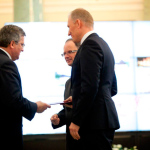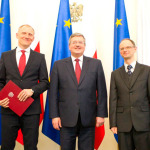The Museum of Papermaking at The Presidential Palace
A ceremony held at the Presidential Palace in Warsaw on 2nd February 2012 saw the handing over of the President of the Republic of Poland’s decree endowing the status of historical monument upon the Duszniki-Zdrój paper mill. The document was received from the hands of the President, Mr Bronisław Komorowski, by the Chief Executive of the Lower Silesian Voivodship, Mr Rafał Jurkowlaniec and the Museum of Papermaking’s director, Mr Maciej Szymczyk. The museum falls within the cultural remit of the Chief Executive’s Office. The ceremony was attended by a host of people connected with the museum. Amongst them were Deputy Chief Executive Mr Radosław Mołoń, the director of the Department of Culture at the Chief Executive’s Office, Mr Jacek Gawroński, the Mayor of Duszniki-Zdrój, Mr Andrzej Rymarczyk, the Chairman of the Association of Polish Papermakers and head of the listed company, Arctic Paper S.A., Mr Michał Jarczyński, the General Director of the Association of Polish Papermakers, Mr Zbigniew Fornalski, the Chairman of International Paper – Kwidzyn S.A., Mr Marek Lrzykowski, the Vice Chairman of PWPW, the Polish Security Printing Works, Mr Piotr Pankanin, the Voivodship Historical Monuments Conservation Officer, Mr Andrzej Kubik, the head of the Wałbrzych Branch of the Office for the Protection of Historical Monuments, Ms Barbara Obelinda-Nowak, former director of the museum Ms Bożena Schweizer-Makowska and its Deputy Director, Ms Joanna Seredyńska.
Under Polish law, the classification of ‘historical monument’ represents the highest form of conservation and protection and is awarded to sites of particular value to the nation’s culture. The significance of the title is elevated by the fact that it is granted only after a process of intensive scrutiny and by special presidential decree, which is why the list of historical monuments is referred to as ‘the Presidential list’. At present it contains 48 sites, including the Jasna Góra (Luminous Mount) monastery, the Teutonic Knights’ Castle in Malbork, the historical districts of Kazimierz Dolny, Krakow, Lublin, Poznań, Toruń, Warsaw, Wrocław and Zamość and the battlefields at Grunwald, Racławice and Westerplatte. To date, seven sites in Lower Silesia have been granted the status, with the Centennial Hall and the Old Town of Wrocław, the basilica in Krzeszów and the fortress on Srebna Góra (Silver Mountain) numbering amongst them.
The process of entering the Museum of Papermaking onto the list of historical monuments was launched at the initiative of the director. The decision to award this status was made on the strength of the fact that the building is the only paper mill in Poland, and one of very few in the world, in so excellent a condition. Note was also taken of something which is extraordinarily rare in industrial buildings, namely the superb polychromes which adorn the wooden walls of the interior. The meeting of history and contemporary times, in the form of the museum’s extremely rich programme of educational activities, which serve as a continuation of the mill’s original spirit and function, played its part in the decision as well.
Maciej Szymczyk, Ph.D. habilitas
Director, Museum of Papermaking






